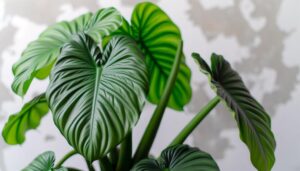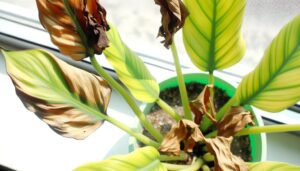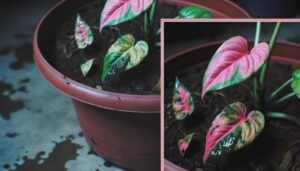What Is a Philodendron Micans Neon?
Philodendron micans 'Neon' is a coveted tropical plant from the understory layers of Central and South American rainforests. The plant boasts velvety, neon green leaves that owe their texture to short trichomes, showcasing its health and vigor.
Ideal growth conditions include temperatures between 18-26°C, humidity above 60%, and bright, indirect light. A well-draining soil mix, enriched with peat moss, perlite, and organic matter, is essential.
Regular watering and a balanced feeding schedule with water-soluble fertilizer contribute to its vibrant foliage. Continued exploration will elucidate more on its care and potential issues.
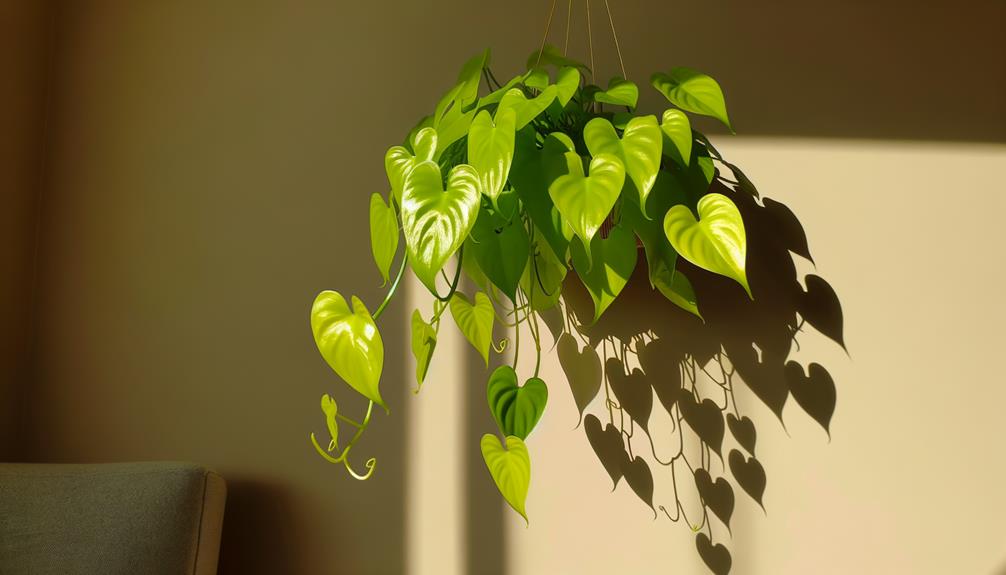
Key Takeaways
- Philodendron Micans Neon originates from Central and South America and thrives in low-light conditions.
- It features velvety leaves with a neon green hue, enhancing its ornamental value.
- The plant has a climbing growth habit, requiring support structures for optimal growth.
- Ideal growing conditions include temperatures of 18-26°C, humidity above 60%, and bright, indirect light.
- It helps improve indoor air quality by filtering toxins like formaldehyde and benzene.
Origins and History

Philodendron Micans Neon, scientifically known as Philodendron hederaceum var. micans, originates from the tropical rainforests of Central and South America where it thrives in the understory layer.
This specific variegation of Philodendron hederaceum is adapted to the low-light conditions of its native habitat, making it an excellent candidate for indoor cultivation.
Historically, the Philodendron genus has been a subject of botanical study since the 19th century, with numerous species and varieties being classified over time. Its introduction into the horticultural market has seen it become a popular houseplant due to its adaptive growth habit and minimal care requirements.
Understanding its origin helps in replicating the natural environment, emphasizing high humidity, indirect light, and well-draining soil for ideal growth.
Unique Features
Philodendron hederaceum 'Micans Neon' is distinguished by its velvety leaf texture, which provides a unique tactile experience and visual appeal.
The plant's neon green hue, a striking variation from the typical green of Philodendron species, enhances its ornamental value.
Additionally, its climbing growth habit necessitates support structures such as trellises or moss poles to facilitate healthy vertical growth.
Velvety Leaf Texture
Characterized by its velvety leaf texture, *Philodendron hederaceum* var. *micans* showcases a unique feature that enhances its appeal among botanists and plant enthusiasts alike.
The foliage of this variety is covered with fine, short trichomes, giving the leaves a soft, suede-like feel. This texture not only adds to its aesthetic charm but also aids in reducing water loss through transpiration.
To maintain the distinct velvety texture, it is essential to provide moderate humidity levels, ideally between 40-60%. Direct sunlight should be avoided, as it can scorch the delicate leaf surface. Instead, bright, indirect light is ideal.
Regular misting and using a humidifier can help recreate the plant's native tropical environment, ensuring the leaves retain their characteristic softness.
Neon Green Hue
Amidst its unique features, the *Philodendron hederaceum* var. *micans* is distinguished by its striking neon green hue, which adds a vibrant contrast to its velvety texture. This luminescent coloration is not only visually appealing but also indicative of the plant's health and vigor.
The neon green hue can be optimized through proper care, including:
- Light Requirements: Provide bright, indirect light to maintain the intensity of the neon green coloration. Avoid direct sunlight to prevent leaf scorch.
- Humidity Levels: Maintain high humidity (60-80%) to support the vivid hue and overall leaf health.
- Nutrient Supply: Regularly provide balanced, water-soluble fertilizers to guarantee the plant receives essential nutrients for sustained vibrancy.
These conditions are crucial for preserving the plant's distinctive coloration.
Climbing Growth Habit
Frequently displaying an impressive climbing growth habit, *Philodendron hederaceum* var. *micans* utilizes its aerial roots to securely anchor itself to various surfaces, enhancing its ability to thrive both indoors and in natural habitats. These roots, emerging from nodes along the stem, enable the plant to scale vertical supports such as totems, trellises, or even tree trunks.
This vining capability not only optimizes light exposure but also encourages vigorous growth. To support this climbing inclination, one should provide a moss pole or similar structure. Regular misting of the aerial roots can improve adherence and nutrient uptake.
Adequate indirect light, combined with well-draining soil, ensures robust growth, while periodic pruning helps manage its expansive nature.
Ideal Growing Conditions
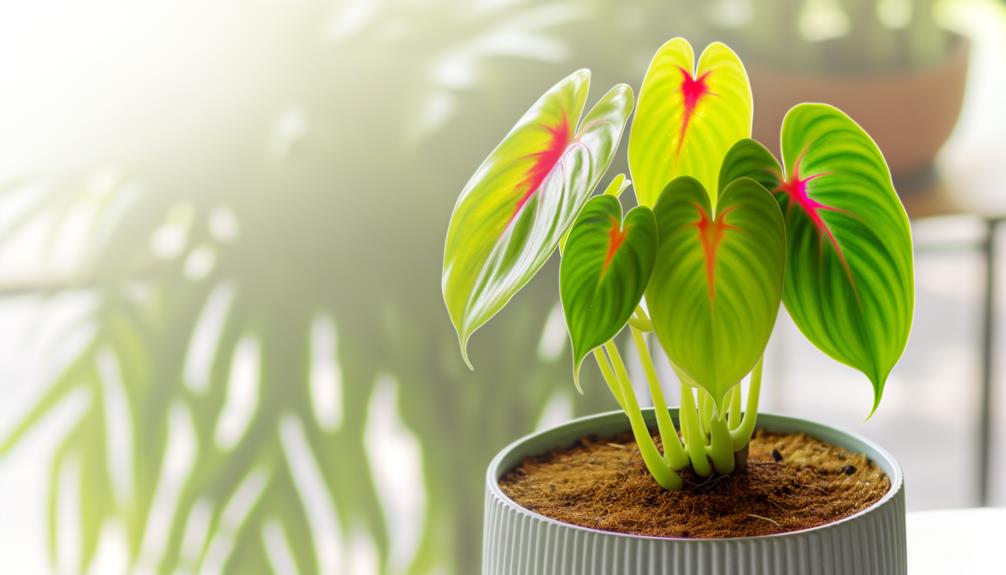
Philodendron micans 'Neon' thrives in a controlled environment where temperatures range between 18-26°C (65-79°F) and humidity levels are consistently maintained above 60%. Ideal growing conditions encompass several critical factors to support the health and growth of this tropical plant.
- Light Requirements: Provide bright, indirect light to mimic its natural understory habitat. Avoid direct sunlight, which can scorch the delicate leaves.
- Soil Composition: Utilize a well-draining, aerated mix, such as a blend of peat, perlite, and orchid bark, to prevent root rot and encourage healthy root development.
- Air Circulation: Maintain good air movement around the plant to reduce fungal issues and support respiratory functions.
These conditions together foster the vibrant foliage and strong growth characteristic of Philodendron micans 'Neon'.
Watering and Feeding
Proper watering and feeding are essential for the best growth of Philodendron hederaceum 'Micans Neon'. Maintaining a consistent watering schedule that keeps the soil moist but not waterlogged, combined with nutrient-rich, well-draining soil, fosters a healthy root system.
Additionally, a regular feeding regimen with a balanced, water-soluble fertilizer during the growing season guarantees the plant receives necessary macro and micronutrients.
Ideal Watering Frequency
Determining the best watering frequency for Philodendron hederaceum var. micans involves understanding its preference for consistently moist but well-draining soil conditions. This epiphytic species thrives when provided with a careful balance between moisture and aeration. Inadequate watering can lead to root rot or dehydration.
To maintain the essential hydration:
- Regular Monitoring: Assess the top inch of the soil; it should remain slightly damp. Water when it feels dry to the touch.
- Seasonal Adjustments: Increase watering frequency during active growth periods (spring and summer) and reduce during dormancy (fall and winter).
- Drainage Considerations: Ensure pots have drainage holes and never allow the plant to sit in standing water.
These guidelines will help safeguard the plant's health and well-being.
Nutrient-Rich Soil
Maintaining peak hydration is just one aspect of care; selecting nutrient-rich, well-aerated soil is equally vital for promoting vigorous growth and overall health of *Philodendron hederaceum* var. *micans*. Utilizing a substrate that is rich in organic matter, such as peat moss or coconut coir, guarantees adequate nutrient availability. Incorporating perlite or orchid bark enhances aeration, preventing root rot and promoting ideal root development.
| Soil Component | Function |
|---|---|
| Peat Moss | Retains moisture, nutrient-rich |
| Coconut Coir | Enhances aeration, sustainable |
| Perlite | Improves drainage, aeration |
| Orchid Bark | Enhances structure, aeration |
| Compost | Adds organic nutrients |
A well-balanced soil mix facilitates consistent nutrient uptake, ensuring the plant's metabolic processes function efficiently. This foundational care promotes a thriving, vibrant appearance.
Feeding Schedule Tips
Consistent and appropriately timed watering, combined with a balanced feeding regimen, is essential for the best development and sustained health of *Philodendron hederaceum* var. *micans*.
This species thrives when its soil moisture is maintained at peak levels without becoming oversaturated. A structured approach to watering and feeding is recommended:
- Watering Frequency: Water when the top 1-2 inches of soil are dry. Overwatering can lead to root rot.
- Feeding Schedule: Apply a balanced, water-soluble fertilizer every 4-6 weeks during the growing season (spring and summer).
- Avoid Dormancy Feeding: Refrain from fertilizing during the plant's dormancy period in fall and winter to prevent nutrient burn.
Adhering to these guidelines guarantees strong growth and vibrant foliage.
Common Issues
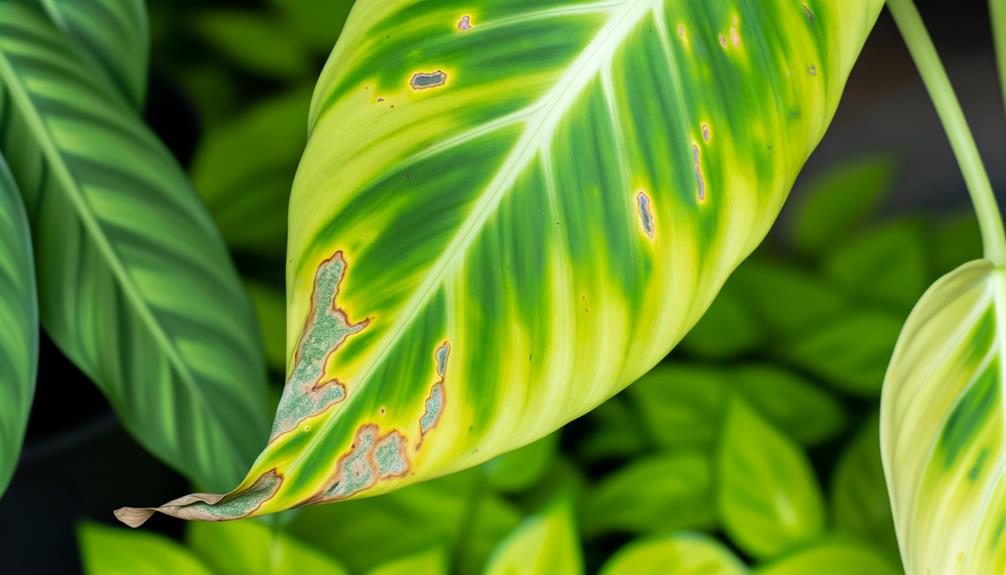
Common issues with Philodendron micans 'Neon' often arise from improper watering practices, leading to root rot or yellowing leaves. Overwatering creates a consistently moist substrate, fostering fungal growth, such as Pythium and Phytophthora species, which causes root rot.
Conversely, underwatering can induce desiccation stress, manifesting as chlorosis or necrosis in foliage. Additionally, inadequate light exposure can result in etiolation, characterized by elongated, pale stems.
This species thrives in indirect light and well-draining, aerated substrates, such as a mix of peat and perlite. Nutrient imbalances, particularly nitrogen deficiency, may also cause leaf yellowing.
Regular inspections for pests, including aphids and spider mites, are essential, as these arthropods can exacerbate stress and lead to further decline in plant health.
Benefits of Ownership
Owning a Philodendron micans 'Neon' provides numerous benefits. One of the key advantages is its ability to improve indoor air quality by filtering airborne toxins such as formaldehyde and benzene. The plant's velvety leaves, with their unique neon hue, contribute to both aesthetic appeal and physiological well-being. Additionally, its low maintenance needs make it ideal for both novice and experienced plant enthusiasts.
Air Purification: Philodendron micans 'Neon' is effective in removing volatile organic compounds (VOCs) from indoor environments.
Aesthetic Appeal: The vibrant neon green foliage adds a striking visual element to any indoor space.
Ease of Care: Requiring minimal light and water, this plant thrives in various indoor conditions, making it suitable for busy lifestyles.
These attributes underscore the plant's value beyond mere decoration.
Conclusion
The Philodendron micans 'Neon' emerges as a botanical marvel, showcasing iridescent foliage that dances with light. Its cultivation history, unique morphological attributes, and specific horticultural requirements underscore its status as a refined choice for indoor greenery.
Proper care, including calibrated watering and nutrient management, mitigates common issues, ensuring vibrant growth. The myriad benefits of owning this species extend beyond aesthetics, offering a verdant touch that elevates the ambience of any space, transforming it into a serene haven.

